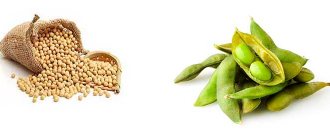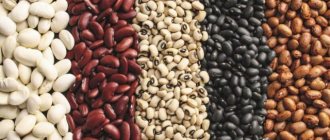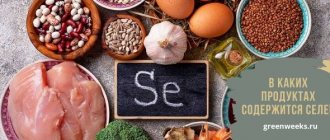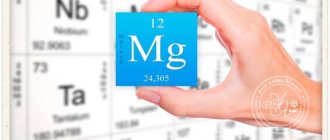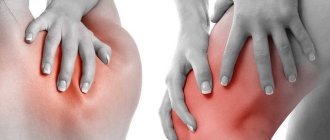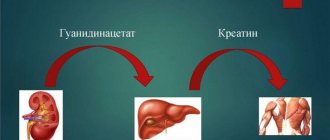Products containing iodine for the thyroid gland are a mandatory part of the diet for many pathological conditions of the body, as well as at the risk of developing diseases. Iodine is one of the trace elements needed by our body. It is absorbed by the cells of the thyroid gland and is part of its secretion. Thyroid hormones play a critical role in metabolic processes. The group of iodine-containing hormones includes the so-called thyroid hormones: triiodothyronine (which includes three iodine atoms in its molecule) and thyroxine or tetraiodothyronine (which includes four iodine atoms and is a chemical precursor of triiodothyronine).
Why does a person need iodine?
Surely many of our readers asked the question, what is iodine and what is its role for the body?
Note!
It is important to know that iodine is not only a product sold in pharmacies for disinfecting and treating cuts or wounds, but also an essential trace element for the functioning of the human body, which we cannot do without. It is he who is responsible for the normal functioning and functioning of the thyroid gland, which produces hormones that are vital for us. A healthy and properly functioning thyroid gland is the guarantee that a person will not have problems with the heart, liver and metabolic processes.
Regular intake of iodine into the body increases the absorption of oxygen by tissues and improves mental activity. A person becomes more cheerful, energetic, and less tired. This microelement has a positive effect on the condition of hair, teeth and skin.
The iodine content in the adult human body is from 20 to 50 mg. Moreover, 60%, that is, most of it, is located in the thyroid gland, and the remaining 40% is distributed throughout the muscles, blood and ovaries.
What elements are important
To prevent a lack of thyroid hormones and for the coordinated functioning of the pituitary-thyroid gland-body system, a sufficient amount of vital microelements and other substances must be present in the daily menu.
Below is a list of the most important components.
Iodine
Iodine is a substrate for the synthesis of thyroxine and triiodothyronine. Consequently, with a low intake of microelements from food, hypothyroidism develops.
At home, a person can get enough iodine by eating regular food. Pathology develops only when the qualitative and quantitative composition of food is violated.
Selenium
According to scientific data, selenium is necessary for the adequate course of metabolic processes in the tissues of the thyroid gland, protecting the cells of the organ from the effects of damaging factors (toxic substances, free radicals, own antibodies, etc.).
Maintaining selenium in the blood at a certain level, according to scientists, is a key factor in preventing any thyroid diseases.
Zinc
Adding zinc-containing foods or specialized supplements has been shown to increase the release of T3 and T4 into the blood. The effect is realized due to the activation of hormone synthesis processes at the level of ribosomal enzymes.
Without selenium, the thyroid gland will not function adequately, even with a significant increase in thyroid-stimulating hormone levels.
If you have thyroid disease, you should never take supplements with selenium, zinc and, especially, iodine on your own. Such an approach to treatment can lead to negative consequences and only worsen the general condition. It is imperative to consult a doctor! Only a specialist can assess the state of health and prescribe adequate therapy corresponding to the severity of the clinical condition.
Iodine as a chemical element
Iodine was first identified and discovered in 1811 by the French chemist Bernard Courtois. When the seaweed ash was heated, purple steam began to be released. It was because of the color that they began to call it iodine, which translated from Greek means violet.
In nature, this type of chemical appears in the form of black crystals with a gray tint and a metallic sheen. Extremely quickly forms vapors with a specific pungent odor.
In the famous periodic table of Mendeleev it is in group 17 and is considered a halogen. Found widespread use in medicine. Iodine is a fairly rare element, but it is very dispersed in nature and can be found almost everywhere.
- in sea water in the form of iodides (25 mg per ton of sea water);
- in kelp seaweed (2.5g per ton of dry seaweed).
Up to 98% of all earthly iodine reserves are found in Chile and Japan. There it is extracted from seaweed, sodium nitrate and other types of raw materials. In Russia, iodine is also extracted from oil drilling waters.
This rare mineral has found its use in many areas of human activity:
- Medicine - the use of alcohol and other solutions as an antiseptic helps to effectively destroy harmful flora.
- Forensics - detection of fingerprints on paper, such as banknotes.
- Technique.
- Light source - halogen lamps, metal halide lamps.
- Battery Manufacturing - Positive electrode component in lithium iodine batteries.
- Laser thermonuclear fusion.
- Radioelectronic industry.
Products low in iodine
Some thyroid diseases require an iodine-free diet. This means you need to select products that either do not contain this element at all or contain it in minimal quantities.
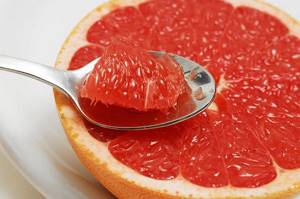
Grapefruit is a fruit suitable for an iodine-free diet
Products that do not contain iodine table:
| Food group | Products with minimal or no iodine content included in the group |
| Fruits (fresh) | Bananas, grapefruits, oranges, tangerines, seedless apples, pears, currants |
| Juices (freshly squeezed) | All except maraschino cherry and rhubarb pressed |
| Vegetables raw, freshly prepared, frozen (no salt) | Everything except potatoes with skins, soybeans, beans: variegated, lima, navy, red, wingu |
| Nuts (no salt) | Peanuts, almonds, nut butter (no salt) |
| Sweets | Sugar, white marshmallows, honey, jelly, maple syrup, unsulfured black molasses |
| Seasonings | Dried and raw herbs, as well as black pepper |
| Vegetable oils | All |
| Beverages | All varieties of coffee, tea, beer, wine and other alcoholic beverages. |
| Egg whites, as well as products of its processing | Egg white omelet, meringue, meringue and so on |
When planning a diet, it should be taken into account that the iodine content decreases during cooking, as well as during long-term storage. For this reason, iodized salt is added to dishes only after heat treatment has been carried out. The table above will help you figure out which foods contain iodine.
Biological role of iodine

As already mentioned, iodine is a trace element and is found in animal tissues and many plants. How much iodine is in plants directly depends on its content in the soil. Certain types of seaweed, namely kelp and fucus, accumulate more than 1% iodine.
It is important!
In the human body, the iodine molecule is part of thyroid hormones, which are produced by the thyroid gland. The role of the thyroid gland is very difficult to overestimate. Thyroxine and triiodotyranine affect metabolism, growth and development of the body.
The daily requirement depends on the condition and age of the body. All biological effects caused by the action of thyroid hormones can be divided into three groups:
- Anabolic effect - influence on tissue growth and differentiation.
- Metabolic effect - increasing the intensity of energy production.
- Sensitizing effects - increasing the sensitivity of cells to the action of other hormones, in particular estrogens and catecholamines.
Iodine, as a trace element, is an integral part of the molecules of active thyroid hormones. The thyroid gland itself produces thyroxine T4, which contains 4 iodine atoms.
This hormone does not have biological activity, but when it enters peripheral tissues through the bloodstream, it is converted into the active hormone T3, respectively, with three iodine atoms. It is this hormone that affects practically all organs and tissues. The thyroid gland produces up to 110 mcg per day. T4.
Normal hormone production is possible only with sufficient iodine intake from food. In cases of insufficient supply of a microelement, the body seeks to somehow compensate for its deficiency.
First of all, a structural restructuring of the gland itself occurs and the central control of the thyroid gland, the central nervous system, namely the hypothalamus, changes. The thyroid gland gradually increases in size, or it occurs in the form of nodes. The consumption of available iodine by the body becomes more economical.
Beneficial features
Experts have identified a list of products containing iodine. An element valuable for all living things is extracted from seaweed ash, as well as solutions of Chilean nitrate. Ancient people used iodine to heal various wounds and scratches. In nature, this substance is found almost everywhere - in minerals, soil, living organisms. The human body receives iodine through food and air. Over time, it accumulates in the thyroid gland, as this organ is responsible for intellectual development and growth. Iodine plays the following biological roles:
- Regulates the development of tissues and cells.
- Controls metabolic processes.
- Promotes stable development of the body.
- Positively affects the development of the cardiovascular system. Normalizes blood pressure, fights tachycardia.
- Ensures stable functioning of the nervous system.
- Positively affects intellectual abilities.
- Helps lower blood cholesterol levels.
- Promotes the full development of the fetus during pregnancy.

Lack of iodine in the body
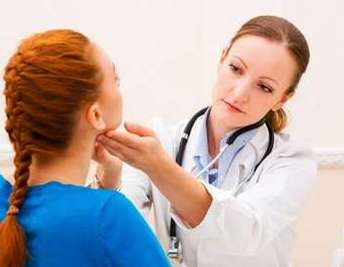
According to statistics from the World Health Organization, around the world, about 2 billion people, which is equal to a third of the world's population, live in conditions of iodine deficiency. On the territory of the CIS countries there are practically no regions with sufficient natural iodine content, both in soil and in water.
As a result, residents of these countries do not receive enough iodine from food for a normal existence. Iodine deficiency most often manifests itself as an enlargement of the thyroid gland - endemic goiter, decreased function of the thyroid gland - hypothyroidism. If children suffer from such a deficiency from birth, it contributes to the development of mental retardation or cretinism.
Congenital hypothyroidism, and general developmental delay, both physical and mental. Iodine deficiency has an extremely adverse effect on women of reproductive age. This leads to infertility, miscarriage or stillbirth. In rare cases, children are born with congenital deformities.

A person suffering from insufficient iodine intake may experience the following symptoms:
- Rapid fatigue is associated with a violation of energy production in every cell of the body.
- Decreased mood, prolonged depressed mood.
- Decreased appetite - reluctance to eat food.
- Weight gain - despite a decrease in appetite, weight increases due to edema.
- Intestinal dysfunction, tendency to constipation.
- Dry skin - the skin becomes dull, thin, flaky, or even covered with horny scales.
- Hair loss is a fairly global phenomenon and immediately becomes noticeable to the patient, hair falls out in clumps, and eyebrows at the temples also thin out.
- Impaired functioning of the cardiovascular system - low blood pressure, shortness of breath, palpitations, irregular heartbeat.
- Memory impairment - this can manifest itself in schoolchildren as decreased academic performance and absent-mindedness.
- Frequent colds are a decrease in immunity and the addition of various pathogenic viruses and bacterial infections.
- Violation of the synthesis of sex hormones - this is manifested by disruption of the menstrual cycle, possible infertility in women. Impaired potency in men.
- In severe cases, an enlargement of the thyroid gland is noticeable to the naked eye. In addition, the enlarged gland can put pressure on the nerve plexuses of the neck. This is manifested by hoarseness of voice, dry, causeless cough, and difficulty swallowing.
Micronutrient deficiency
When a person experiences an acute shortage of a useful substance, he begins to look for which foods contain iodine. The list of products is very diverse, so it is always possible to create a complete diet. Iodine deficiency can manifest itself in completely different ways. The most common symptoms are headaches, deterioration of attention and memory, and increased blood pressure. A person’s emotional state may also suffer. If the problem is left unattended for a long time, arrhythmia, increased heart pressure, and atherosclerosis cannot be ruled out. The main signs of iodine deficiency include swelling of the face and hands, weakness, and muscle pain. Experienced doctors note that the main symptoms of a lack of a multifunctional microelement include:
- Lethargy and drowsiness.
- Dyspnea.
- Decreased appetite.
- Fast fatiguability.
- Deterioration of memory and attention.
- Dry skin.
- Increase in body weight.
- Frequent headaches.
- Heartache.
- Frequent colds, sore throats.
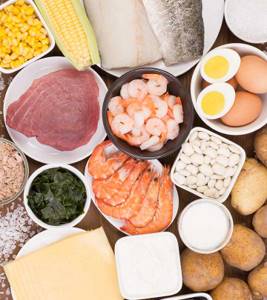
Causes of iodine deficiency in the body
The global cause of iodine deficiency , as already mentioned, is the natural uneven distribution of iodine in water and soil on the planet. Of course, you can solve this problem by settling in a coastal area. Residents of countries and regions that live on the shores of seas and oceans very rarely suffer from iodine deficiency. But this solution is not suitable for everyone.
In second place is poor nutrition. Eating foods that contain iodine does not meet the daily requirement for it. This may affect people with a low social standard of living, those serving in the army, prisoners, and others.
Problems with the gastrointestinal tract often impair the absorption and absorption of iodine. Some chemical microelements also interfere with the absorption of beneficial iodine in the intestines - these are: bromine, manganese, calcium, chlorine, cobalt.
A heavily polluted environment or living near chemical plants, nuclear power plants and factories with harmful emissions can contribute to iodine deficiency. Taking medications is another important factor that causes iodine deficiency.
Description of the important element
Iodine is a chemical element that in its natural form has a solid consistency, and not liquid, as everyone used to think. In large quantities it is dangerous for humans, which is why you need to be as careful as possible. Iodine is found in almost all foods, even water and air. The maximum concentration of this element is found in salty sea water. There is slightly less iodine in the air and soil of marine regions. A person replenishes reserves of the substance from food, and only then from the environment.
Who is at risk
Most of all, iodine is needed by that category of people in whose body active growth and development occurs. Of course, these are women during pregnancy and lactation.
A small organism growing in a woman should not experience a deficiency in thyroid hormones. Children also need more iodine throughout their growth and development.
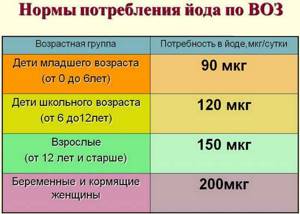
- Children under 1 year of age require 50 mcg/day.
- Children 2–7 years old - 92 mcg/day.
- Children 8–13 years old 120 mcg/day.
- Adolescents (12 years and older) and adults 150 mcg/day.
- Pregnant and breastfeeding women 200 mcg/day.
- Elderly people 100 mcg/day.
Interesting Facts
Only when a person knows where iodine is found in optimal concentration will he be able to replenish the natural balance of the microelement in his body. The substance itself boasts some useful facts:
- Experts have repeatedly proven that an increase in the size of the thyroid gland can occur not only due to a lack of iodine, but also due to its increased concentration. If a person has increased activity of this organ, this may indicate a slow metabolism and increased body weight. An underactive thyroid gland often leads to increased metabolism and weight loss.
- Only salt to which a valuable chemical element is added can be called iodized. It should be noted that today Americans eat just such a product. Thanks to this, they are guaranteed to replenish their iodine reserves daily.
- Microelement deficiency is dangerous for newborn babies. Nutritionists recommend that vegetarians closely monitor their iodine intake. Especially during pregnancy and lactation.
- Iodized salt is extremely rare in prepared foods and seasonings. If it is still present in the composition, it will be indicated on the packaging.
You should not overuse sea salt, as it helps wash calcium out of the body. The food product may have a negative effect on blood pressure. In some cases, water is retained, causing swelling of the limbs and face.
Foods that contain iodine

Fortunately, in stores we can find a sufficient number of high-quality products, thanks to which replenishing the daily iodine requirement will not be difficult.
As already mentioned, seaweed is the leader in the amount of iodine. Laminaria and fuchsia contain up to 200 mcg per 100 grams of weight. Thus, by eating only 100 grams of seaweed, you can get the required amount of iodine.
Of course, we must take into account the specific taste and smell of seaweed and that not all people can eat it. In this case, manufacturers can please us with dry seaweed, which can be added to food as a seasoning.
Let's take a closer look at which foods contain large amounts of iodine.
Sea fish
This type of living beings is capable of accumulating iodine in its tissues. In this regard, not only fish, but also seafood are especially useful. Here is a partial list of iodine content per 100 grams of weight:
- cod liver – 350 mcg/100 g;
- tuna -145 mcg/100 g;
- shrimp -190 mcg/100 g;
- oysters - 60 mcg/100 g;
- salmon, flounder - 200 mcg/100 g;
- pink salmon, chum salmon - 50 mcg/100 g.
Animal meat and dairy products

Meat and milk are also sources of iodine for the body. In terms of microelement content, these products are, of course, inferior to fish, but they should not be neglected. Milk, in addition to iodine, can provide your body with calcium, proteins and many vitamins.
- pork meat - 17 mcg/100 g
- beef meat -12 mcg/100 g;
- milk - 20 mcg/100 g;
- cheeses - 11 mcg/100 g;
- butter - 10 mcg/100 g.
Vegetables and fruits

With modern methods of growing plants, it is impossible to say with certainty that the iodine content in vegetables and fruits sold on the market meets any standards, but it is simply necessary to include these products in the diet.
- apples with seeds - 70 mcg/100 g;
- persimmon - 30 mcg/100 g;
- feijoa - 70 mcg/100 g;
- beets - 7 mcg/100 g;
- potatoes - 7 mcg/100 g;
- carrots - 5 mcg/100 g;
- sorrel - 3 mcg/100 g.
This is not the entire list of products that contain iodine ; it also includes red caviar, buckwheat, and other types of seafood.
Additional ways to enrich the body with iodine
These are, first of all, medications containing iodine.
Yes, I hear your cries that this is no longer the natural iodine found in “live” foods! And you are absolutely right, friends!
But sometimes it becomes the only salvation!!!
In which cases?
These are, first of all, allergic reactions of the body to certain foods.
For many, the high cost, first of all, of sea fish, seafood, and fruits becomes this reason.
Another way to enrich body cells with this substance is to regularly visit the sea and frequent walks along the coast. Physical and breathing exercises on the seashore are especially effective.
Foods high in iodine
Iodine deficiency leads to depression, loss of strength, excess weight gain and poor brain function. So that we can avoid all these health problems, it is important to properly plan our diet and know which foods contain a lot of iodine. Let's take a closer look at the list of iodine-rich foods.
Iodine content in food products. Table

We already know that iodine plays a major role in the normal functioning of the thyroid gland, and the better it works, the higher the metabolic rate in the body. Iodine also promotes efficient burning of calories: turning them into necessary energy, rather than into harmful fat.
An essential microelement strengthens hair roots, preventing hair loss, improves immunity, and reduces the risk of cancer.
It is important!
Pregnant women should be extremely attentive to their health and monitor the level of iodine in the body. After all, the lack of this element is one of the main causes of illness and mental retardation in newborn children.
These conclusions were made by the World Health Organization based on global research data.
- It is known that the required daily intake of iodine is 150 mcg.
- And for pregnant women - 250 mcg.
The norm of iodine that we need can be obtained even when living far from the sea; it is enough to include foods containing iodine in the diet, and they will certainly be found in the kitchen of every good housewife.
Cranberry
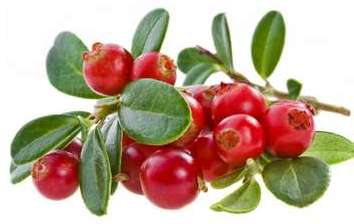
The small sour berry contains a huge amount of valuable vitamins, antioxidants, nutrients and microelements, including vitamin K, which promotes good absorption of calcium, vitamin C, fiber and iodine.
100 grams of cranberries contain 350 mcg of iodine.
It is recommended to add fresh cranberries to salads, sauces, baked goods, and make fruit drinks and juices from the berries - then you will be provided with the daily requirement of iodine.
Strawberry

This sweet red berry contains quite a large amount of iodine:
One cup of strawberries contains approximately 13 mcg, which is about 10% of the daily value of iodine.
Strawberries also regulate blood pressure, strengthen the immune system, and thanks to vitamin C, reduce “bad cholesterol” in the blood.
Prunes
These dried fruits have many important and beneficial properties for our health: regulates blood sugar, which reduces the risk of obesity and type 2 diabetes, prevents cancer, strengthens bones, and lowers cholesterol.
Just 5 pieces of prunes contain 13 mcg of iodine.
Prunes also contain vitamin K and beta carotene. Eating foods containing beta carotene makes people happier and improves their mood, according to research conducted by The Harvard School of Public Health in 2013.
Shrimps
All seafood contains a lot of iodine, however, among all marine life, shrimp occupy a special place.
100 grams of these crustaceans contain 40 mcg of iodine.
Shrimp contain astaxanthin, a powerful antioxidant that effectively fights free radicals, which are the cause of many of our diseases. A large number of scientific studies have confirmed that astaxanthin has shown itself to improve the functioning of the brain and nervous system, as it reduces brain diseases and improves memory.
Cod
This white fish is low in calories and fat, but it is rich in vitamins and beneficial microelements, including iodine.
A 100 gram serving of cod contains 110 mcg of iodine.
Cod has a lot of calcium, it is also rich in phosphorus, potassium, magnesium, B vitamins, vitamin E, especially vitamin B12, which is beneficial for the functioning of the heart and takes an active part in the functioning of the heart and blood vessels.
Tuna
Although tuna is a fattier fish than cod, it is also very healthy. A particularly valuable property of tuna is its ability to prevent such a serious disease as stroke.
100 grams of tuna contain about 18 mcg of iodine.
This fish also contains a lot of iron, magnesium, calcium, phosphorus and vitamins.
Recent studies have confirmed that people who eat tuna 4-5 times a week have a 30% reduced risk of stroke.
Turkey
Everyone loves turkey meat: both those losing weight for its small percentage of fat and athletes for its high protein content. But another thing to love about turkey is that it is a healthy source of iodine.
100 grams of turkey meat contains about 37 mcg of iodine.
Also, the meat of this bird has a high concentration of other useful substances: iron, phosphorus, potassium, zinc, calcium and vitamins. Prepare a delicious turkey dish and saturate your body with everything it needs for health.
Potato
Many people are critical of eating potatoes, because they have a high starch content, and this can add extra weight. But sometimes you can and even need to eat potatoes.
It contains: iron, zinc, phosphorus, calcium - these microelements help strengthen bones, Vitamin B6 prevents nervous disorders, helps absorb proteins and fats, as well as potassium and magnesium.
One medium-sized potato contains 60 mcg of iodine, which is half the daily intake of this microelement.
It is better to eat potatoes by baking them than by mashing them with butter or full-fat milk.
Beans
Dishes made from beans are rich in iodine and tasty, and they are also very good for health: beans contain a lot of fiber and have a low glycemic index, which is important for people with diabetes. After all, it is known that the GI level helps to lower or increase blood sugar.
100 grams of beans contain 30 mcg of iodine.
In addition, beans are rich in magnesium, zinc, copper, and folic acid, which is needed to create new cells and maintain them in a healthy state.
Sea kale
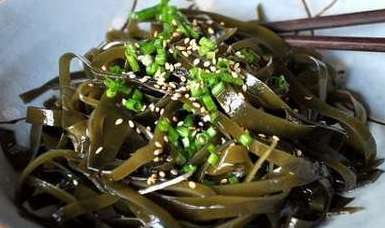
These algae are a real leader in iodine content, on par with cranberries.
It is important to know that 100 grams of seaweed contain approximately 300 mcg of iodine, which is 2 times more than the daily requirement!
Also, sea kale is rich in vitamins, microelements and very low in calories, per 100 grams there are only 25 calories and there are almost no carbohydrates and fats - it is a godsend for people losing weight. It is from seaweed that the famous nori sheets are made for rolling rolls.
Iodine provision for bottle-fed children
Do all children need prevention of iodine deficiency? What foods in children's diets are sources of iodine? What are the requirements for formula feeding?
Introduction
It is unlikely that anyone will dare to challenge the assertion that his health in childhood and throughout his entire subsequent life largely depends on proper feeding of a child in the first year of life. The science of infant feeding is not only the most important, but also the most complex section of children's dietetics. For this reason, increased attention is rightfully paid to the selection of optimal and rational nutrition for children in the first stage of postnatal life.
It is well known that in Russia, breastfeeding in terms of prevalence is currently at an unacceptably low level. Our own data, obtained on a fairly large sample of children born in rural areas in the last quarter of the twentieth century (about 2.5 thousand respondents), convincingly confirm this fact. Almost every fourth child is already bottle-fed by 3 months, and by the end of the first six months of life, more than half of all children receive breast milk substitutes (Fig. 1). According to some reports, in cities this issue is even more acute, and the number of women who do not breastfeed continues to grow.
At the same time, over the past decades, approaches to the organization of artificial feeding have changed significantly. In the absence of milk from the mother, the doctor is forced to look for an adequate “replacement” for it. Such a “replacement” should maximally satisfy the growing needs of the baby and meet his physiological needs for all vital components of nutrition.
These components also include the most important “nutrient of intelligence” - the microelement iodine. It is part of the thyroid hormones, which are the most important regulators of the maturation of the human central nervous system at the postnatal stage of development. According to the latest developments of the National Academy of Sciences (USA), in the first 6 months of life, a child should receive up to 110 mcg of iodine per day, in the second half of the year - at least 130 mcg.
With iodine deficiency, a complex of abnormalities develops in the functioning of a number of systems and organs of the baby. Iodine deficiency has always been a pressing problem for Russia. The importance and relevance of this problem were recognized at the state level (RF Government Decree No. 1119 of 10/05/99). But if in recent years the adult population of the Russian Federation has already gained the opportunity to replenish iodine reserves through mass consumption of iodized salt, then for young children, especially for such a group at critical risk of iodine deficiency pathology as newborns and infants, iodine prophylaxis has not yet been adapted to modern requirements.
In connection with the above, pediatricians and family doctors should pay special attention to the problem of iodine provision for young children, which requires prompt resolution at the current level of scientific knowledge and practical capabilities. This publication serves as a continuation of the conversation on this topic that we began in No. 10 of the “Attending Physician” magazine for 2001. Let us recall that at that time we were talking about modern ideas regarding the physiological role of iodine in the composition of thyroid hormones, its importance in the development of a healthy child, and the pathological effects of iodine deficiency on the child’s body at the prenatal stage and in the first years of life. We covered in detail the issues of prenatal iodine prophylaxis. In addition, we presented an original algorithm for choosing the optimal way to supply iodine to children receiving breast (natural) feeding, and mentioned the sources of microelement intake when replacing breast milk with artificial formulas.
Now we offer significantly expanded and significantly revised material on the organization of iodine prophylaxis in children who are bottle-fed. The information base for the analysis below is made up of modern information on the actual iodine content in 130 baby food products in the first year of life - in adapted and medicinal formulas (70), as well as in complementary feeding products (60). We consider it important and appropriate to supplement the characteristics of commercial products fortified with iodine for young children with detailed reference tables, which we first developed for marketing purposes and, we hope, will assist many doctors and nutritionists in their practical work. Due to the rapidly changing market conditions, we would appreciate everyone's constructive criticism and any comments.
Group classification of iodine sources for artificial feeding of children
The subsequent discussion of the qualitative parameters and quantitative characteristics of iodized products for artificial feeding and complementary feeding of children in the first year of life is based on the original classification, presented in the form of a table. 1. The identification of four groups of iodine-containing human milk substitutes, two groups of cereals and three types of other complementary foods is necessary to clarify the following main practical aspects of the problem:
- what foods in a child’s diet should be considered real sources of iodine;
- in what dose when feeding a specific product should additional pharmacological preparations of iodine be administered in order to adequately ensure the high physiological need for this microelement.
These issues can be easily resolved if information about the actual iodine content in 100 g or 100 ml of a ready-to-eat product is taken as the main classification criterion (taking into account differences in the amount of microelement in the dry powder, in the method of culinary preparation of the mixture or porridge, in portion packaging and etc.). In table Table 1, along with such information, provides calculated data on iodine consumption with a particular food, depending on the approximate volume (mass) of the digestible product, which changes with the age of the child. Comparison of the presented indicators by group with the required values of proper microelement provision by half-year allows us to adequately assess the size of individual iodine deficiency and outline effective ways to correct it.
In general, three fundamental features can be identified that characterize the situation in providing iodine to bottle-fed children: the abundance of iodine-containing products (more than a hundred); extreme quantitative variability of iodine additives in different products; lack of formulas and complementary foods enriched with a sufficient dose of iodine and capable of fully satisfying the child’s high physiological need for this microelement during the first year of life.
Let's move on to a detailed description of breast milk substitutes and complementary feeding products based on their characteristics in the selected groups, as well as individual characteristics.
Iodine provision of children of the first year of life with formulas - substitutes for mother's milk
Currently, on the federal baby food market, 12 foreign and one domestic manufacturing company present 70 products containing iodine. It is noteworthy that the only Russian product is included in the group of the lowest dosed iodine, and other domestic mixtures do not contain it at all.
The largest amount of microelement - more than 10 µg/dL of the finished product - is contained in mixtures produced using technologies from Humana and Heinz (Fig. 2). This is not surprising, since Germany, like Russia, is one of the countries experiencing acute iodine deficiency. It should be noted that Humana is one of the manufacturers supplying the widest range of iodine-enriched formulas for artificial feeding of children to the Russian Federation (Fig. 3).
In table 2 provides an individual analysis of the most popular breast milk substitutes in Russia, carried out taking into account the requirements for them by a pediatric endocrinologist: data is provided on the amount of iodine received by a child per day when consuming a particular formula, depending on age, volume of formula consumed and type of substitute breast milk. When choosing a product based on the amount of iodine it contains, priority should be given not so much to the brand name of the mixture being evaluated, but rather to the actual quantitative characteristics of the product (the recipe on the package).
| Figure 4. Proportion (%) of baby food products for artificial feeding in the first year of life, depending on the degree of iodine enrichment (divided into groups according to Table 1) |
All food products listed are fortified with iodine, and the quantitative range ranges from 3 to 19 mcg per 100 ml of the finished mixture. Thus, these products can be divided into four groups. 100 ml of the finished mixture included in the first group contains less than 6 mcg of iodine, the second - from 6 to 9, the third - from 9 to 12, and finally, the fourth - 12 mcg or more. We especially emphasize that only when using mixtures from the last group and only in the first 5 months of life is it possible to fully provide the baby with iodine in accordance with his needs and without the additional use of iodine-containing drugs: at this time, the average intake of the microelement with mixtures included in the fourth group is are about 90–110 mcg (with individual parameters varying from 84 to 171 mcg). The share of these substitutes among all iodine-containing mixtures is extremely small - only about 21%; (Fig. 4). But even these products, due to the subsequent age-related reduction in the volume of their consumption, provide iodine in a dosage that is below the average threshold (50 mcg) and is not able to cover the needs of the child’s body, which in the second half of the year already needs up to 130 mcg of iodine (Fig. 5). Feeding with formulas from all other groups requires the mandatory introduction of additional portions of iodine (see below).
Of course, when choosing a formula, the doctor and parents need to focus on the balance of its composition in all the main ingredients (proteins, fats, carbohydrates), vitamins, other microelements, and also take into account other clinical and physiological characteristics of the baby.
Iodine provision of children of the first year of life with complementary foods
Potentially, in the second half of the first year of life, iodine can enter the body with some complementary feeding products - in cereals and cookies specially enriched with this microelement, and a little later - in the form of meat and fish purees prepared with iodine additives and, finally, with iodized bread.
In recent years, 60 iodine-containing cereals have been sold in the Russian Federation, and only imported ones. They are supplied to our market by six foreign companies, among which, again, the Humana company is the leader - both in the degree of saturation of products with microelements (Fig. 6) and in the richness of the assortment (Fig. 7).
| Figure 7. Rating of companies by the number of cereals produced for artificial feeding, fortified with iodine |
It should be recognized that the iodine content in complementary feeding products of different production also varies significantly - from 1.4 to 17.5 mcg in 100 ml of ready-made cereals. Table data 3 indicate that due to the relatively small volume of porridge eaten by the child, the amount of iodine in them does not reach the recommended preventive threshold. In this regard, when assessing iodine intake, such products should be considered only as an additional (non-main) source of the microelement.
In our opinion, it is necessary to distinguish at least two groups of iodized cereals: with the addition of microelements in doses of less than 10 mcg/dl - group “A” and more saturated ones - group “B” (Table 1). In the second half of the year (from 7 months), the child receives about 25 mcg of iodine (from 15.5 to 35) per day with cereals from group “B”. And this amount is important to take into account both when assessing the total iodine diet and when planning individual iodine prophylaxis with pharmacological preparations. But, as in the situation with mixtures, the share of cereals saturated with a large dose of iodine in our market, unfortunately, is small - approximately two-thirds of all iodized cereals (Fig. 8).
| Figure 8. Proportion (%) of baby cereals for artificial feeding in the first year of life, depending on the degree of iodine enrichment (divided into groups according to Table 1) |
Porridges from group “A” are less enriched with iodine than others, so this product can be neglected when analyzing the daily balance of the microelement. This approach is also valid for the “symbolic” iodine supplement supplied in meat/fish purees and iodized bread.
The optimal way to provide iodine to children in the first year of life when bottle-fed
In the practice of feeding a child, it is necessary to take into account a number of circumstances (type of feeding - natural or artificial, use of milk substitutes and complementary foods enriched with high doses of iodine, general somatic and nutritional status of the child, his allergy history, material wealth in the family, etc.), which, certainly requires drawing up an individual plan for iodine prophylaxis. For this purpose, we have previously developed and already published an algorithm for individualizing baby food at an early age based on iodine content.
In this message, we present an improved fragment of it, which will allow optimizing artificial feeding of children, taking into account the above information (Table 4). Children who are bottle-fed, depending on whether a particular milk replacer belongs to a low- or high-dose group, must be prescribed one of the potassium iodide preparations in adequate quantities from birth (groups 1–3) or from the second half of the year (group 4).
Literature
- Kon I. Ya. Artificial feeding of children in the first year of life: modern ideas and problems // Consilium medicum. 1999. T. I. No. 6.
- Ladodo K. S. Fundamentals of rational nutrition for children. Kyiv, 1987, p. 18-46.
- Pampura A.N., Strakhova M.S., Cheburkin A.A. Dietary prevention of allergic diseases in children in the first six months of life // Attending Physician. 2001. No. 7. P. 48.
- Studenikin M. Ya., Ladodo K. S. Nutrition of young children. M.: Medicine, 1991.
- Tsaregorodtseva L.V. Features of feeding young children with diseases of the gastrointestinal tract of functional origin // Attending Doctor. 2001. No. 9. P. 39.
- Tsaregorodtseva L.V. Features of a therapeutic diet in young children with acute digestive disorders // Treating Doctor. 2001. No. 10. P. 18.
- Shilin D. E., Pykov M. I., Logacheva T. S., Volodina M. N., Kasatkina E. P. Iodine prophylaxis in children of the first year of life // Attending Physician. 2001. No. 10. P. 4-11.
- D. Dietary guidelines for young children in North America. Proceedings of the 6th international symposium “Infant nutrition - new data and modern approaches.” 1998, October, Moscow, Russia. M., 1998. pp. 15-17.
- HUMANA: Baby food program for healthy and sick children in the first year of life. MARIA-HUMANA, 2001. 58 p.
- IDD Newsletter. 2001. Vol. 17. No. 1. P. 15.
- Pedersen KM, Laurberg P., Nohr S., Jorgensen A., Andersen S. Iodine in drinking water varies by more than 100-fold in Denmark: Importance for iodine content of infant formulas // Eur. J. Endocrinol. 1999. Vol. 140. P. 400-403.
Iodized salt

There are three options for preventing iodine deficiency:
- mass;
- group;
- individual.
From the point of view of economic benefit and efficiency, mass prevention comes first. Its essence is to add iodine salts (iodates) to the most commonly consumed food product. Thus, the most universal method is iodization of ordinary table salt.
Salt is consumed by all segments of the population, regardless of income level and social status. The only drawback may be the unusual smell of iodine and possible taste. The standard used is that for every kilogram of table salt, 4 mg is added. potassium iodate.
With an average salt consumption of 7 to 10 g/day, taking into account the 50% loss of iodine during storage and cooking, this level provides the human body with 150 mcg of iodine per day.
For the best effect, salt must be used correctly. It must be stored in an airtight container for no more than 4 months. It is advisable to salt already prepared dishes to prevent the evaporation of iodine.
What to avoid
The diet of persons whose production of T3 and T4 is reduced must be subject to mandatory correction.
There are prohibited foods that cannot be eaten if you have a sick thyroid gland.
A number of substances depress the function of the thyroid gland and reduce the production of hormones.
Scientists have identified the following elements that are harmful to people with a hypothyroid background:
- Goitrogens. They are special chemical compounds that can slow down the transformation of triiodothyronine into thyroxine in thyroid cells. As a result, a compensatory enlargement of the endocrine organ develops. The richest in this substance are: soy products, vegetables (cabbage, spinach), fruits and berries (peaches, strawberries), nuts (peanuts).
- Gluten. It is a protein found in grain crops (wheat, rye). Increased consumption of gluten with a complicated medical history (presence of autoimmune diseases) several times increases the likelihood of clinical manifestation of Hashimoto's thyroiditis.
You should also avoid highly processed foods (fast food, cakes, baked goods) and alcoholic beverages.
Excess iodine

When a person consumes foods rich in iodine in combination with drugs that replenish iodine deficiency, a state of iodine excess may occur. As you know, an excess, just like a lack of microelements, can have an extremely negative impact on health.
Fortunately, there is little chance of encountering such a situation in reality, because iodine is quickly eliminated from the body.
Symptoms of excess iodine:
- weakness;
- recurrent headaches;
- metallic taste in the mouth;
- hyperthermia;
- disruption of the heart.
Products of plant origin
Even those who prefer vegetarian food can replenish their supply of this valuable substance. There are a huge number of plant products containing iodine:
- Laminaria (sea kale). 120 g of this product is enough to completely meet your daily iodine requirement. Since pickled seaweed is a heavy product, it is better to make a casserole from it.
- Buckwheat porridge.
- Persimmon. This fruit is rich in iodine compounds. Persimmons also contain useful magnesium, iron, sodium, and vitamins.
- Apple seeds. You can eat no more than 6 grains per day. If overused, symptoms of iodine overload may develop. Only seeds of ripe apples can be eaten.
- Bananas. One fruit contains 4-6 g of iodine. Bananas are well digestible and do not have a negative effect on the stomach.
- Feijoa. Iodine is contained not only in ripe pulp, but also in the peel.
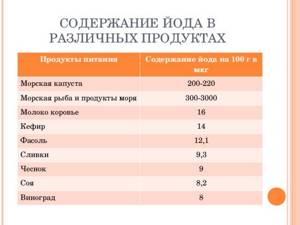
Myths and truth about iodine

At the end of our conversation, we will discuss with you important and frequently asked questions by many people regarding iodine:
There are many different opinions of people around the problem of iodine deficiency. Sometimes people tend to solve the problem of lack of this microelement in an unconventional way.
Is it true that iodine deficiency in the body can be determined at home by applying an iodine grid?
Iodine deficiency and iodine network. There is an opinion that if you apply a mesh of an alcohol solution of iodine to the skin and it becomes dull, this is a sure sign of iodine deficiency. Of course, this is not true; no skin tests can determine the level of any trace element in the body. A deficiency of any microelement in the body can only be determined using laboratory analysis (for iodine content, urine is taken for analysis).
Is it true that if you drink a drop of an alcohol solution of iodine you can fill your daily requirement?
Do not do this under any circumstances! This is not only an incorrect statement, but also quite dangerous. And not because this drop contains 30 times more iodine than a person needs per day. The fact is that the alcohol solution can cause burns to the mucous membrane of the oropharynx and esophagus and the thyroid gland will be seriously damaged.
Do I need to take additional tablets that contain iodine?
Almost all of us have heard and seen popular commercials for Yodamarin and other iodine-containing drugs. It is important to remember that adults and children can take such drugs only after they have been prescribed by a doctor. After all, only he can prescribe the right dosage for you. Under no circumstances should you self-medicate!
Such drugs should be taken only as directed by a doctor! It is important to eat properly and balanced. Include in your diet both foods containing iodine and foods rich in other important microelements, and this will be enough for the well-being and health of most of us.
Is it true that a lack of iodine has a detrimental effect on the overall health and body?
Yes this is true. The fact is that with a regular lack of iodine, a person begins to experience a lack of strength, notice that he gets tired very quickly, feels overwhelmed and completely exhausted. Usually this condition is attributed to a general banal malaise. But everything is much more serious and these are the first signs that the body is experiencing iodine deficiency.
What interferes with absorption and reduces the amount in the body
There are foods that interfere with the absorption of iodine:
- corn;
- soy;
- cabbage;
- turnip;
- dill;
- mustard.

Reduce the level of absorption of this microelement and medication :
- sulfa drugs;
- Levomycetin;
- Streptomycin;
- Erythromycin;
- penicillin;
- bromine.
The level of iodine absorption from food decreases with intestinal dysbiosis. Chlorine and fluorine - substances contained in tap water - displace this element from the body.
Chokeberry, its beneficial properties and contraindications for use! How this plant will help cope with many diseases, advice from traditional medicine.
Read in our article all about the benefits of sea buckthorn berries. We will tell you what essential vitamins and nutrients sea buckthorn contains, and what its indications are for certain diseases.
Do you know what healing properties pumpkin juice has? Find ways to prepare a healing drink here:.
Highly iodized products
A list of foods that have a high iodine concentration is presented in the table:

| Who are the products recommended for? | List of products |
| The products are indicated for people with hypothyroidism, a dysfunction of the thyroid gland that leads to a decrease in iodine levels in the body. |
|
Deficiency and surplus
Lack of iodine leads to serious disturbances in the functioning of the body. Among the most common causes of mineral deficiency are an incorrect diet, lack of seafood, iodine metabolism disorders, taking medications that impede the absorption of the microelement, environmental pollution, and high sensitivity to allergens.
When there is a lack of iodine, the thyroid gland is the first to suffer. It loses activity, which leads to the development of hypothyroidism, which is manifested by swelling of the mucous membranes, slowing of metabolism, and aging of the skin. Excessive iodine content is the cause of hyperthyroidism. Against this background, Graves' disease and endemic goiter occur.
Iodine deficiency provokes the development of numerous negative phenomena.
- Emotional instability, which is accompanied by drowsiness, irritability or apathy, lethargy, forgetfulness, blues, and causeless bad mood.
- Low hemoglobin level.
- Cardiac problems: arrhythmia, increased lower blood pressure or atherosclerosis.
- Swelling around the eyes, face or hands. Muscle pain, radiculitis, weakness.
In children, prolonged iodine deficiency leads to delays in mental, mental and physical development. Lack of microelements during pregnancy causes cretinism in the child and serious disturbances in the formation of the skeletal system and brain. In the early stages, iodine deficiency can cause miscarriage and placental abruption, and during lactation – poor milk production.
Most often, a lack of mineral is indicated by loss of appetite, fatigue, weakness or bad mood, problems with hearing, memory, periodic headaches, severe hair loss, tooth decay or excessive dry skin, frequent colds or viral diseases, poor heat tolerance, shortness of breath and painful sensations in the heart.
Excess iodine is very rare. It is usually accompanied by symptoms of a cold and causes hives and other allergic reactions. Mucus production may increase.
Products are leaders in iodine content
To maintain iodine balance, you need to choose the right foods.
Among the leaders in microelement content are seafood and fruits: bananas, citrus fruits, watermelon, melon, apples, grapes, persimmons and strawberries. The list of vegetables is topped by eggplants, onions, garlic, radishes and spinach. There is a lot of iodine in peanuts, sweet corn, champignons, beans, kefir and chocolate. Table of iodine content in foods
| Name | Content, mcg |
| Squid meat | 300 |
| Sea kale | 300 |
| Hake, pollock, haddock | 150 |
| Grape | 8 |
| Garlic | 9 |
| Radish | 8 |
| Carrot | 5 |
| Beans | 12 |
| Millet | 10 |
| Barley grits | 9 |
| Oatmeal | 8 |
| Lentils | 4 |
| Kefir, yogurt, milk, curdled milk | 9 |
| Fat sour cream | 7 |
| Condensed milk | 7 |
| Crackers | 10 |
| Eggs | 20 |
| Chicken fillet | 6 |
| Pistachios | 10 |
| Beef liver | 6 |
It is important to remember that trace elements disappear very quickly, especially when boiling. To replenish the mineral deficiency with iodized salt, it should be added to prepared meals and stored in airtight containers. It is not recommended to use salt for longer than 3-4 months, otherwise there will be no iodine left in it at all.
Some fruits and berries contain iodine - bananas, citruses, watermelons, melons, apples, grapes, persimmons and strawberries.
One of the richest foods in iodine is seaweed. However, it is important to take into account that its use provokes the production of thyroid hormones. This activity is accompanied by increased use of oxygen by cells, which can cause negative consequences in the presence of malignant tumors.

